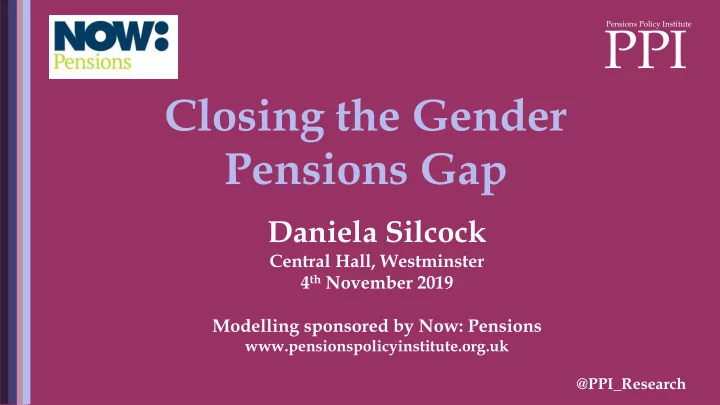

PPI Pensions Policy Institute Closing the Gender Pensions Gap Daniela Silcock Central Hall, Westminster 4 th November 2019 Modelling sponsored by Now: Pensions www.pensionspolicyinstitute.org.uk @PPI_Research
The two policies help smooth contribution levels PPI Pensions Policy Institute during working life The projected pension contributions of women currently aged 22 under a typical life course (2019 earnings terms) 1 £2,500 Full-time Takes time off for caring Returns part-time Works full-time Family-carer top-up Employer Employee £2,000 2025: Introduction of the removal of lower band earnings Contributions £1,500 £1,000 £500 £0 22 27 32 37 42 47 52 57 62 67 Age 1 PPI modelling
The two policies combined could make up around two PPI Pensions Policy Institute thirds of the difference between working full time and taking time out for caring The projected pension savings of women currently aged 22 under a typical life course (2019 earnings terms) 1 £140,000 Takes time off for caring Returns part-time Works full-time Full-time £115,400 £120,000 Current policy Family carer top-up £100,000 Pension fund value £87,800 Family carer top-up and contributions from the first pound £80,000 Full time under Family carer top-up and contributions from the first £64,000 pound £60,000 £41,000 2025: Introduction of £40,000 the removal of lower band earnings £20,000 £- 22 27 32 37 42 47 52 57 62 67 Age 1 PPI modelling
The policies reduce the differences between men and PPI Pensions Policy Institute women but do not fully compensate for time out or the gender pay gap Projected AE pension pot at retirement (2019 earnings terms) with a family carer top-up and contributions from the first pound 1 £120,000 Family carer top-up + Contributions from the first pound Family carer top-up £100,000 18,500 18,500 Current policy - 1,100 £80,000 18,500 Pension pot value 18,500 - 18,500 £60,000 18,500 10,300 19,400 88,900 87,000 17,500 £40,000 70,200 52,200 £20,000 38,900 31,800 £0 Full time Takes one year break at Full time Takes a 10 year break at Takes a 16 year break at Takes a 10 year break at age 26 as a family carer, age 25 as a family carer, age 26 as a family carer, age 25 as family carer, returns to work full time returns to work full time returns part-time until returns full time. Exits age 50 then full-time to labour market at age 55 to Spa care for family Male Female Life courses 1 PPI modelling
The two policies could reduce the gap by around PPI Pensions Policy Institute 50% Proportion of gender gap attributable to different factors and extent to which policies reduce the gap 1 100 80 45 Second order 2 Index effect 14 60 7 100 1 28 40 22 73 0 50 20 - Male pension Differing Gender pay Participation Scheme type Tendancy to Womens Family carer Contributions Women - All wealth working gap rates retire early pension wealth top-up from the first policies patterns pound 1 PPI modelling
The two policies address both working pattern PPI Pensions Policy Institute differences and the pay gap Proportion of gender gap attributable to different factors and extent to which policies reduce the gap 1 100 80 45 Index 60 100 1 28 40 22 0 50 20 - Male pension wealth Differing working Gender pay gap Participation rates Scheme type Tendancy to retire Womens pension (Current policy) patterns early wealth (Current policy) 1 PPI modelling
The two policies address both working pattern PPI Pensions Policy Institute differences and the pay gap Proportion of gender gap attributable to different factors and extent to which policies reduce the gap 1 100 80 41 Index 60 4 1 100 25 22 40 0 3 57 20 - Male pension wealth Differing working Gender pay gap Participation rates Scheme type Tendancy to retire Womens pension (Current policy) patterns early wealth 1 PPI modelling
The two policies address both working pattern PPI Pensions Policy Institute differences and the pay gap Proportion of gender gap attributable to different factors and extent to which policies reduce the gap 1 100 31 80 1 Index 10 22 60 19 4 100 0 6 3 40 73 20 - Male pension wealth Differing working Gender pay gap Participation rates Scheme type Tendancy to retire Womens pension (Current policy) patterns early wealth 1 PPI modelling
The two policies combines would cost an extra PPI Pensions Policy Institute £6.1 billion per year Extra costs arising from policies to Government, employers and employees, aggregate (2019 earnings terms) 1 +£2.7bn +£0.3bn £37,200 +£0.9bn Current policy £22,030 +£0.9bn Family carer top-up Contributions from the first pound £6,310 +£1.2bn Contributions from the first pound (additional tax relief) £0 £5,000 £10,000 £15,000 £20,000 £25,000 £30,000 £35,000 £40,000 £45,000 Cost (m) 1 WAS Wave 5, ONS MQ5 Table 4.3 Self- administered pension funds’ income and expenditure, ONS PEN2 Personal Pensions (including stakeholder pensions): Scheme members’ annual contributions and DWP analysis
PPI Pensions Policy Institute Thank you for listening Any questions?
Recommend
More recommend